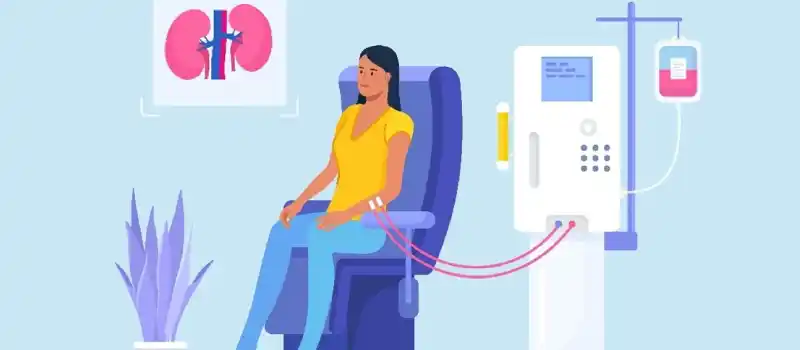During kidney failure, if you are advised that you need treatment to stay alive, it can be a crucial time in your life. If you are newly diagnosed with kidney disease, you may feel devastated, puzzled, and annoyed. But you can help yourself by doing some important things. Review your different treatment options and take an active role in decisions about your care.
How does hemodialysis work?
Hemodialysis is a treatment that replaces the work of your own kidneys to clear extra fluid and wastes from your blood.
Home hemodialysis (HD) occurs at stage 5 chronic kidney disease (CKD) and is a treatment for kidney failure, which is also called end-stage renal disease (ESRD). It is done in the comfort of your own home with slightly different equipment, and the basic process is the same as in-center hemodialysis.
During home hemodialysis, blood flows through a dialysis machine from the patient’s vascular access point. Home dialysis cleanses the blood of extra waste and fluids and sends the clean blood back into the body. This is performed using a special filter called a dialyzer, or artificial kidney.
At the start of each treatment, two needles are inserted into your access point. To carry blood to the dialyzer, needles are connected to plastic tubing. At any one time, only a small amount of blood is out of your body. The dialysis machine controls the treatment time, fluid removal, pressure, and temperature while it pumps your blood through the dialysis system.
In-home hemodialysis, the basic process is the same, except that you and a member of your care team are trained to do your treatment at home.

Hemodialysis: In-center or at home
You can do hemodialysis at a dialysis center, where tasks during treatment are performed by a nurse or technician. In-center hemodialysis is usually done for about three to four hours or longer, three times a week. There is a pre-scheduled time for in-center treatments.
Hemodialysis can also be done at home, where you are the one doing your treatment. You may be better able to fit your treatments into your daily schedule at home.
Different types of home hemodialysis
The following are three types of hemodialysis that can be performed at home:
- Conventional home hemodialysis: You do this for three to four hours or longer each time, three times a week. Training is provided to you and your care partner to do dialysis safely and to handle any problems that may arise. Training may take several weeks to a few months.
- Short daily home hemodialysis: This is typically performed using new machines designed for short daily home treatment, five to seven times per week, for two hours each. The training for you and your care partner may be for several weeks. Less fluid generally needs to be removed each time, since you are doing dialysis more often. This reduces symptoms like cramping, nausea, headaches, and feeling “washed out” after treatment.
- Nocturnal home hemodialysis: During the night, long, slow treatments are done while you sleep. You may do this kind of dialysis six nights a week or every other night or as prescribed by your physician, and treatments usually last about six to eight hours. The training for you and your care partner may last several weeks. Some centers oversee your treatments by sending information from your dialysis machine by telephone, modem or the Internet to a staffed location. More hours of dialysis each week can result in more removal of waste.
It is also possible to combine both daily and nocturnal home hemodialysis. The combination of treatments depends on your medical condition, your needs, and your machine.
Benefits of short daily and nocturnal home hemodialysis:
Below are some of the potential benefits:
- More energy for daily tasks
- Better sleep
- Fewer and shorter hospital stays
- Better quality of life
- Taking less medication to control blood pressure and anemia
- Taking less medication to keep phosphorus under control to help prevent bone disease
- Improvements in neuropathy (nerve damage)
- Feeling better during dialysis including less nausea
Benefits of home hemodialysis:
- You may be able to do home dialysis on your own without assistance.
- The comfort of being home during treatment and having access to an on-call nurse over the phone.
- You can stay on your machine longer or more frequently, which can help you feel better. In addition, you may have more energy and less nausea as prescribed by your physician.
- You have more flexibility for work or school or other social activities as advised by your physician and you can choose the time for treatments.
- You save time and transportation costs as you do not have to leave home.
- Some people prefer that they or their care partner put in needles.
- You have more freedom with your diet if your physician prescribes more frequent dialysis treatments.
New machines and technology
For home hemodialysis, new and easy-to-use machines are being developed. These are clean, easier to set up, and sanitized. If you think home hemodialysis is a good choice for you, ask your physician about the best equipment for you.
It is important to know if you are getting the right amount of dialysis, whatever treatment option you choose. To check the amount of dialysis you receive, tests should be done regularly. For more information, speak with your physician and your dialysis care team.
To schedule an appointment with us, please visit – Southwest Kidney Institute OR Contact Us – 480.610.6100